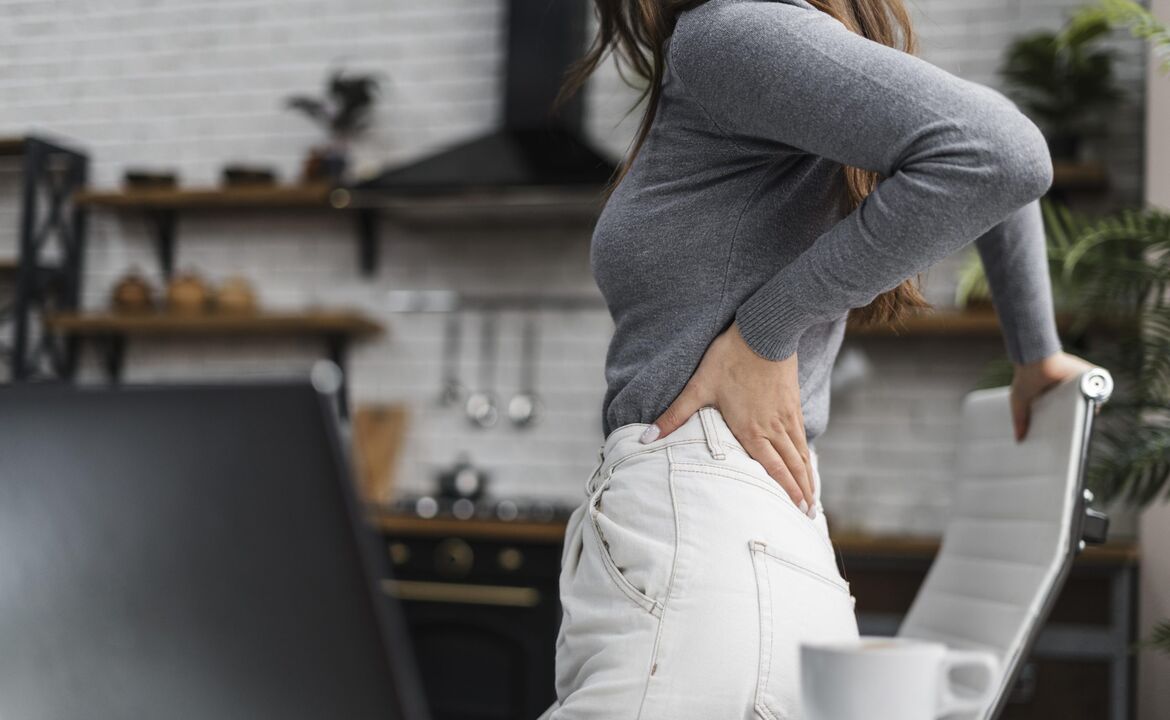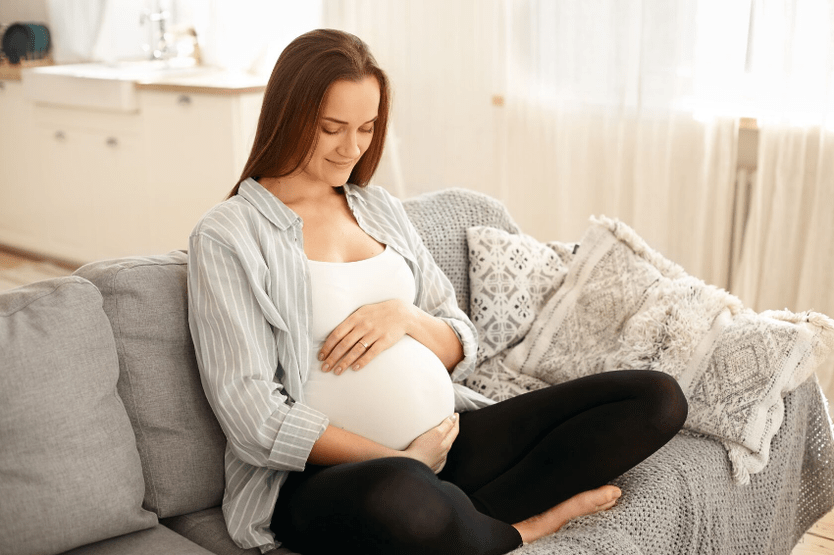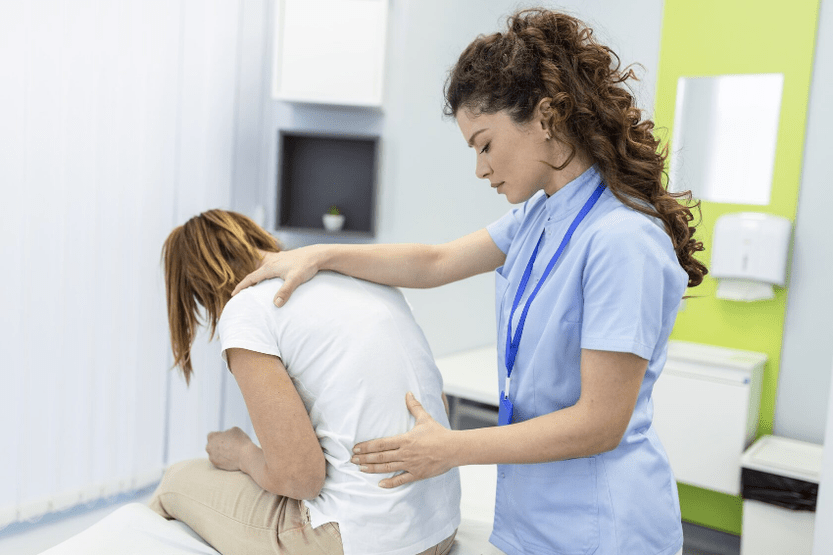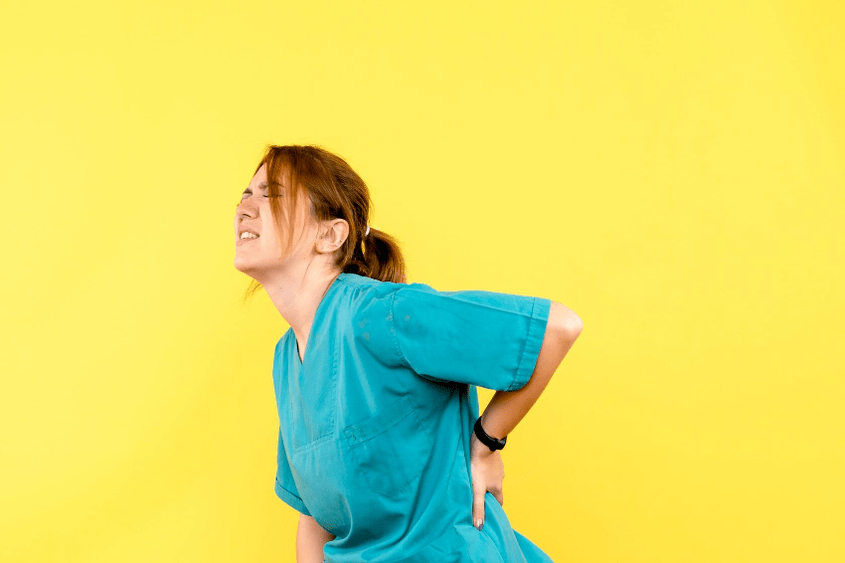
Back pain in the lumbar region can indicate various diseases of the spine, disorders in the connection of nerve structures, injuries to internal organs, soft tissues and oncological tumors. Pain syndrome can have different intensity and type of manifestation. Depending on the type of pain that occurs, pathology can be identified. However, to obtain an accurate diagnosis, an examination including instrumental diagnostics is carried out. This will help you find out why the pain occurs. Based on the examination results, the doctor selects the treatment.
Types of pain
Back pain in the lumbar region may indicate the development of serious diseases. But in most cases the symptoms are harmless and are related to the influence of various external factors:
- hypothermia;
- staying in an uncomfortable position for a long time;
- compression of blood vessels;
- Soft tissue damage due to trauma.
When diagnosing back pain, the doctor pays attention to the type of severity and duration. If the pain occurs due to a cold or simple hypothermia, it completely disappears 2 weeks after using ointments containing non-steroidal anti-inflammatory components. They do not help to cure the disease, but after that it does not hurt to move.
If the pain in the spine does not go away despite local medications and sometimes worsens, a comprehensive examination is required. In some cases, such a symptom is an alarming sign of the development of dangerous diseases. In diseases of the spine, at the time of an attack, pain can radiate to different areas of the body: leg, arm, groin. Often such an attack is accompanied by unpleasant sensations in the body: numbness, tingling, goosebumps, burning.
In most cases, pain in the lumbar region occurs suddenly, is acute and resembles lumbago (lumbago). Patients themselves describe the pain as sharp, stabbing, sometimes pressing and less intense. At the moment of an attack, a person's movements are limited and straightening of the lower back is possible only through pain. Movement does not provide relief and sometimes causes increased pain. The acute condition can last only a few minutes, but sometimes it lasts a day or longer.
Women and men over 50, as well as people who have suffered serious injuries, suffer from chronic lower back pain. In this case it is constant but bearable; Patients notice only mild discomfort, stiffness of movement in the morning and pain at night. Chronic pain attacks can be triggered by stress, heavy lifting or hypothermia. The rest of the time there is no pain, there is stiffness and discomfort.
Lower back pain in pregnant women
Women often suffer from back pain during pregnancy. Its appearance is associated with natural changes. As the fetus grows around the second trimester of pregnancy, a shift in the center of gravity occurs, resulting in a postural deformity with a deflection in the lumbar region. This change is not dangerous, it occurs abruptly in more than 70% of women, but it must be monitored as it can lead to serious health problems in the future.
No special treatment is carried out during pregnancy. To reduce the intensity of painful attacks, the doctor may recommend that the woman take NSAIDs externally. In some cases, wearing support structures is recommended to ensure proper load distribution on the spine.

Expectant mothers should also not neglect the general rules: they need to rest regularly and avoid wearing high-heeled shoes. Be careful when bending over to pick something up. Straighten your back and straighten up, then you need to get up as slowly as possible. When choosing a bed at home, you should also make sure it should be comfortable.
Pain at night and in the morning
If severe discomfort bothers a person especially at night and occurs in the morning immediately after waking up, the problem should be looked for in the quality of sleep at night. The manifestation of strong painful sensations is associated with incorrect posture at night during rest. The first thing you need to do at home is to replace the mattress, bed and pillows. It would be good if the bed was orthopedic.
If pain is observed only in the morning, it is worth considering the possibility of sudden movements after waking up. It is better to get up earlier and do a light warm-up of the muscles and joints while lying in bed. If you perform such exercises regularly, you can forget about the manifestation of pain. You will find it much easier to bend over and the feeling that your back is stiff will disappear. After warming up, you will find it easier to get up.
It should also be borne in mind that the spine and lower back suffer from excess weight. The problem of back pain occurs more often in overweight people, as well as in patients with a sedentary lifestyle. After normalizing behavior and improving the quality of night's sleep, periodic pains disappear if they are not associated with diseases.
Pain in the lower back radiates down the leg
Pain that occurs in the back can radiate throughout the body. Most often it radiates to the leg and can affect part of the foot and extend to the heel. The cause of pain is sciatica, lumbago or radiculitis, i. e. pathologies that are accompanied by damage to the nerve tissue. Due to changes in the structure of cartilage tissue, which lead to deformation of the vertebrae and the formation of osteophytes, pinching of nerve endings occurs, against the background of which attacks of severe pain arise that radiate to the leg.
Acute pain
The duration of acute pain attacks varies. They can last from a few minutes to many weeks. Chronic pain can manifest itself unnoticed and acutely to a person; the patient gets used to it and may no longer feel it when the attack is over.
Acute, unbearable pain attacks in the lumbar region are characteristic of various diseases:
- scoliosis;
- myositis;
- Arthritis;
- Arthrosis;
- neurological lesions;
- tumor processes;
- osteomyelitis;
- Spondylitis
If the pain has a stabbing character, it means that the roots of the spinal cord are involved in the pathological inflammatory process. If the pain appears monotonous and dull and spreads to the abdominal cavity, liver inflammation should be considered. Severe seizures that disrupt consciousness and lead to its loss may indicate urolithiasis or pyelonephritis.
Causes of lower back pain
Back pain in the lumbar region can have different causes. Many of them lead to the development of pathologies that significantly reduce the quality of life and in which pain becomes a constant companion. Trying to deal with the problem alone is practically pointless and difficult; accurate diagnosis and selection of competent treatment can only be made on the basis of the results of instrumental diagnostics.
The most common causes of back pain:
- intervertebral hernia protrusions;
- osteochondrosis;
- dysfunction of the gastrointestinal tract;
- curvature of the spine;
- tumors;
- damage to muscles and ligaments;
- Soft tissue infections.

Often the cause of pain is simple hypothermia, which affects the largest nerve in the human body, the sciatic nerve. In addition, against the background of hypothermia, entrapment can occur, leading to acute pain. Other factors can trigger attacks:
- physical inactivity;
- excessive nervous tension;
- Hard physical work;
- Damage and injuries.
Lower back pain can occur with urolithiasis; they accompany a seizure. They are also characteristic of many sexually transmitted diseases. Lumbar pain in women is not always pathological. It is a physiological norm when it occurs before menstrual bleeding or at the beginning of menopause. In these cases, the symptoms are not dangerous and can be controlled by using painkillers. With all of the listed pathologies, it is problematic to move, bend over, or do any work at home.
Spinal diseases
The main cause of lower back pain is various diseases, deformities and lesions of the spine. Pain can be of very different nature. The intensity of their severity depends on many factors and varies greatly depending on the part of the spine affected. The most commonly observed types of pain are:
- periodically;
- local or local;
- pulling or pushing;
- burning and cutting;
- Shoot.
The intensity of symptomatic manifestations may depend on stress, uncomfortable sitting in a chair, sports and physical activity. The discomfort increases when you stand or sit awkwardly. When muscle fibers spasm, lumbago is observed and the entire area hurts. With such pain there is stiffness of movement, the symptom spreads to the back of the thigh and can reach the calves and even the feet. Much depends on the type of disease and its nature. The pathology must be treated by a specialist.
Intervertebral hernia
In later stages of development, disc hernias of the lumbar spine with osteochondrosis often form. They usually predominantly cover the lumbar area and lower back and form between the 4th and 5th. vertebrae and in the sacral area. The pain syndrome in this case is unpleasant, intrusive, it is accompanied by damage to the nerve roots and weak blood circulation occurs. The pain is similar to that of radiculitis and increases when you stand or sit in an uncomfortable chair. If the hernia formation is large, it compresses the spinal cord, loss of sensitivity occurs, and in complicated cases paralysis is possible because the hernia gets between the intervertebral discs.
You can understand what bothers you about an intervertebral hernia using the following episodes:
- it is impossible to stand on a chair or other surface without support, this is due to the increased load on the intervertebral discs;
- lying on your stomach is extremely uncomfortable;
- a feeling of stiffness in the back;
- it is difficult to bend forward;
- Arching of the back is not possible due to the pain that hinders movement.
Hernias are treated conservatively and surgically. Depending on the patient's condition, the appropriate method is determined. Conservative treatment of the disease is ineffective in advanced cases.
Rachiocampsis
There is no pain with minor curvatures. Feelings of tiredness may occur; you want to spend more time lying down because the pain gets worse when standing or sitting. Various neurological disorders occur in second-degree deformities. At this stage, pain occurs, which can be moderate and moderately intense on the left and right. As the disease progresses, the symptoms worsen throughout the day; in advanced forms, they become unbearable and are not relieved by local and systemic painkillers. It is difficult to completely eliminate the manifestation, the curvature can be quickly cured.

osteoporosis
This disease often occurs in men and women over the age of 50. The pathology is characterized by rapid loss of bone tissue. Due to such loss, brittleness occurs, the vertebrae become less strong, and damage is possible with even minor injuries, physical exertion, or heavy lifting. Patients only bend over because of discomfort and return from the bended position with severe pain. In order for a person to pick something up from the floor, it is better to sit down, straighten your back and then straighten up. Sitting down first will reduce the health risks of osteoporosis.
Pain from osteoporosis is not just due to fractures. The disease is dangerous, it can be used to register a group of disabled people.
Injuries to the vertebral acid
The most common injury is a bruise. If it is mild, there will be moderate discomfort. It tends to worsen with exercise throughout the day, causing local swelling with bruising and bleeding. The symptom always increases with movement and sporting activity. In severe cases, the problem is not only painful, it can also be accompanied by neurological disorders, especially if nerve endings are involved in the process. It is impossible to completely eliminate the problem, and it is not always possible to cure the consequences of injuries even surgically.
Soft tissue and kidney injuries
With soft tissue bruises, mild pain occurs, which subsides after local application of anti-inflammatory agents. The pain is always local, the injured area is swollen and bleeding is possible.
If, in combination with the symptoms described, pain in the lumbar region on the left is accompanied by the appearance of blood in the urine, there is damage to the kidney. The symptoms become more intense; with severe injuries to the organs of the excretory system, urination is impaired or becomes impossible. Hematomas may occur on the lower back. The development of shock and life-threatening conditions cannot be ruled out.
Spinal infections
Infectious lesions of the spine are more dangerous. Osteomyelitis can be:
- postoperative;
- post-traumatic;
- Contact;
- hematogenous.
In acute cases, the disease progresses at lightning speed. It is characterized by increasing symptoms of pain that intensify throughout the day, accompanied by high body temperature and a very severe deterioration in general condition. The nature of the discomfort can be different: twitching, pressing, bursting. The attacks are severe, hinder movements and force you to remain in one position because it hurts to move. In chronic pathologies, fistulas may occur with the formation of purulent discharge.
A rare but dangerous disease of the spine is spinal tuberculosis. Even in the early stages of development, it causes deep and very severe pain in the abdomen, which peaks after physical activity. The gait of men and women becomes stiff. Due to the destruction of the bone structures, the nerve roots are compressed, the pain burns and spreads into the lower body.
With a spinal epidural abscess, the pain is quite deep, very severe, accompanied by chills and muscle tension. Against the background of progress, the radicular syndrome intensifies, paresis occurs, and the function of the pelvic organs is disrupted.
Muscle damage
Pain in the lower lumbar region may occur after physical activity, lifting weights, or intense training sessions. It also manifests itself when staying in a static position for a long time with tension in the lower back and glutes.
With such a lesion, the discomfort appears less severe at rest and after rest after applying a warming ointment. Muscle damage or myositis occurs not only against the background of infections. It can be provoked by stress and hypothermia of the body, severe intoxication and metabolic disorders. The disease is usually accompanied by aching pain.
Myofascial syndrome
Myofascial syndrome is classified as a painful condition in which lower back discomfort is accompanied by painful muscle tension. During an attack, trigger points appear in the affected area. The sources of pain are muscles and fascia, connective tissue. To treat this pathology, specialists prescribe painkillers, non-steroidal anti-inflammatory drugs and sedatives.
In some cases it is advisable to treat the disease with centrally acting muscle relaxants. Such agents are intended to reduce tonic tension, reduce arousal and cause relaxation of the muscles involved in the spasm to allow the person to bend. In some cases, specialists resort to point blockade by administering anesthetics.
Tumors of the spine, kidneys
Tumors of the spine and spinal cord are quite rare. The frequency of detection of such diseases is no more than 0. 5% of the total number of diagnosed cancers. Neoplasms can be either benign or malignant. Depending on this, the forecast varies considerably.
The characteristic symptom of this pathology is pain in the lumbar region. If the etiology is benign, the symptoms are alleviated with the use of medications. If the formation is malignant, treatment must be complex and often limited to surgery.
Pain in the lower back on the left can also be due to kidney cancer. It will have a pronounced character, it may hurt, press, burst. Over time, the symptoms increase and urination problems occur. Do not steam or heat the affected area. After removing the formation, normalization of the condition is possible.
What to do after acute back pain?
If acute back pain occurs for a short time, you can get the situation under control yourself. If possible, you should see a specialist and undergo an examination to reduce the risk of another attack.
If you have the following symptoms, you should urgently contact a specialist:
- Lower back pain of any kind lasts for a week;
- against the background of pain, body temperature rises;
- discomfort appeared at the site of previous injuries and damage;
- the pain spreads to the whole body;
- The sensitivity of certain areas is lost.

In these cases, pain cannot be ignored. It is important to see a doctor and start treatment as soon as possible, otherwise the disease will progress.
Which doctor should I contact?
If you suspect the development of diseases of the musculoskeletal system, you should consult a traumatologist or neurologist. Specialists conduct an examination and physical examination and prescribe the necessary instrumental examination. If your back suddenly hurts, you can call an ambulance. You can use pain relieving gels at home.
If you suspect that pain in the lumbar region is due to kidney damage, you should consult a urologist or nephrologist. You can also see a therapist. Any of the specialists will tell you what to do with pain in the lower back that manifests itself against the background of kidney disease, and will also prescribe an additional examination. Laboratory tests of the patient's blood and urine are required; they serve to confirm or refute the disease.
If women experience sporadic lower back pain associated with menstruation or menopause, it is worth discussing this problem with a gynecologist. A specialist will help you choose a treatment that will eliminate the discomfort. In cases where you need to clarify the cause of the pain syndrome, you should consult a therapist, family doctor or family doctor. The doctor conducts an examination and determines the preliminary cause of the violation.
diagnosis
There are many factors that can cause pain in the lumbar region, so even an experienced doctor cannot make an accurate diagnosis without an examination. The following methods are used as part of diagnostics:
- X-ray examination of the painful area;
- MRI;
- Ultrasound of the pelvic and abdominal organs;
- general analysis of urine and blood;
- Electroneuromyography.
If pain occurs against the background of diseases of the genitourinary system or gastrointestinal tract, an endoscopic examination of the intestines may be required. If there is a suspicion of the development of neoplasms in the body, a biochemical blood test is carried out.
Treatment
The intervention regimen necessary to treat back pain is selected individually. The main rule is that therapy should be comprehensive, including symptomatic treatment and lifestyle changes. Treatment is selected after the doctor determines the cause of the pain.
Regardless of the cause of back pain, all patients should adhere to these rules:
- Do not lift heavy objects.
- When sitting, lean forward and straighten your back;
- avoid strenuous sports;
- If you are obese, you should lose weight;
- Change your sleeping place and make yourself comfortable.
- Conducting regular minutes of physical education directly while sitting on a chair or armchair;
- light sports;
- do not take a steam bath, do not visit a sauna, do not take a hot bath;
- Wearing a support bandage (as prescribed by a doctor).
If spinal diseases are diagnosed, the treatment complex also includes the following recommendations:
- Medical influence. The use of painkillers, anti-inflammatory and decongestants is indicated. The drugs can be prescribed for oral administration and for topical application in the form of a pain-relieving cream, gel or ointment.
- Blockage of the lumbar region.
- Physical therapy. Patients are prescribed physiotherapy, massage, magnetic therapy and electrophoresis.
- Acupuncture, manual therapy, osteopathy.
In severe cases, when conservative interventions for spinal diseases do not bring results, surgical intervention is performed.
The information in the article should not be used as a basis for self-diagnosis and treatment, but is for informational purposes only. You should not take any medication without consulting a specialist.
Trying to figure out how to get rid of lower back pain and why your back hurts on your own is almost pointless. It can be of different nature depending on which effective method of influence is chosen. Self-medication is ineffective and dangerous for many pathologies, as it leads to a worsening of the condition.

















































